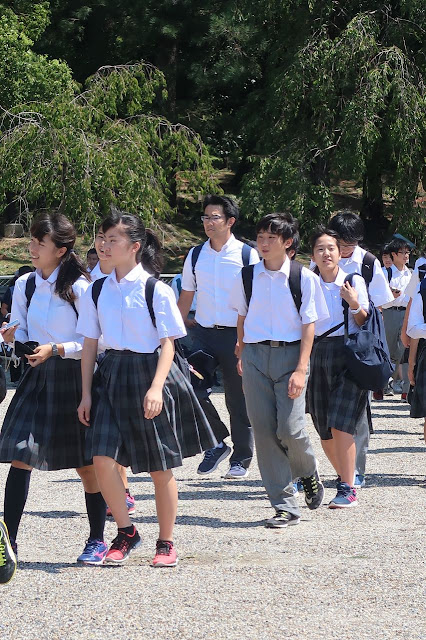Japan’s first permanent capital during the 8th century before the imperial base was moved to Kyoto, Nara still retains the atmosphere of ancient Japan and has some of the most beautiful temples and shrines in the country. Noted for its many ancient Japanese Buddhist temples and Shinto shrines, Nara is home to eight historical sites belonging to the UNESCO World Heritage of Ancient Nara, and include Todai-ji which is home to the largest bronze statue of the Buddha in the world, to the serene Isuien Gardens and sublime Kasuga Taisha Shrine deep in the lush primeval Kasugayama Forest. Linked to the maritime Silk Roads through Osaka in the 8th century, Nara developed as a cultural hub where Japanese, Chinese and Korean influences came together, and thus became a religious centre for both Buddhism and Shintoism, two of the many religions that spread along the lengths of the Silk Roads that were relayed by pilgrims, monks and indeed merchants themselves. Believed to be the birthplace of sake, tofu was also introduced to Japan during the Nara period by Zen Buddhist monks, who initially called it "Chinese curd". Throughout the vast parklands that link Kōfukuji and Tōdaiji, there are thousands of tame deer that have been around since Nara was founded in 710. Said to be messengers of the gods, deer feature in many Shinto and Buddhist legends, and have strong symbolic connections within the religious landscape of Japan — along with deer cookies.
Nara deer are very brazen and constantly in search of deer cookies known as shika sembei,
that are sold by vendors around Nara-koen Park
Deer cookies area made from a mixture of rice and flour and even the paper ties are edible
Nara's nearly 1200 deer have become a symbol of the city and have even been designated as a natural treasure
Local musician busking by the park
Gojūnotō five-storied Buddhist Pagoda at Kōfukuji was built originally in 725
by Empress Komyo and later restored in 1426
Japanese students on a school trip to Kōfukuji
Nan’endō is a sub-temple on the grounds of Kōfukuji, one of the most influential temples
in the history of Japanese Buddhism
Nan’endō was first contsructed in 813 by Fuyutsugu Fujiwara, but was rebuilt in 1741
Water ladles at a chōzubachi are used by worshippers to purify themselves
before approaching Shinto shrines
Hitokoto Kannon is a little temple adjacent to Nan’endo
Deer have been considered to be divine messengers of the gods since ancient times,
and feature in many Shinto and Buddhist legends
Ochatho Tokiwa Teahouse beside Isuien Garden
Tamago Zosui, a Japanese rice soup with egg, at Ochatho Tokiwa beside Isuien Garden
Cold Soba on ice with sliced omelet and Tsukemono, Japanese pickles
Tsuyu dipping sauce for the soba, made with dash stock, mirin and soy sauce
Tsukemono of pickled nozawana (mustard leaf) and kombu (kelp)
Entrance to Isuien Garden which has been preserved since its creation in the Meiji era
Natural waterfall in the garden
Sanshutei Tea House with a thatched roof is reached by crossing a narrow bridge
across a small pond
Stone bridge across a small brook
Lush and verdant, Isuien is full of moss covered stones and landscapes
The stepping-stones are old millstones used in the manufacture of fabric dyes, are a reference to the profession of the original garden's owner, who made fine quality textiles
A rain rock attached by twine to the tea house eavestrough encourages the rain to gently
run down without making a sound
Groundskeeper busy after the typhoon
The Seishuan Tea House
Our lovely guide who voluntarily toured us around the garden to practice her english
Isuien Garden is landscaped in the Japanese Shakkei style - or "borrowed landscape" - in which the surroundings are incorporated such as the roof of the large southern door of Tōdai-ji Temple
Throughout the vast parklands that link Kōfukuji and Tōdaiji, there are thousands of tame deer that have been in Nara since it was founded in 710
Japanese lady getting a 'selfie' with one of the divine messengers
Tōdai-ji is one of Japan's most famous and historically significant temples and a landmark of Nara
Todai-ji is the largest temple in Nara and home of the Great Buddha known as Daibutsu
Hall of the Great Buddha (Daibutsuden) is the world's largest timber building
and home to the Great Buddha which is largest cast bronze statue in the world
The Great South Nandaimon Gate, a two-story structure guarding the Todai-ji temple entrance
A mother and daughter admiring a young fawn by Nandaimon Gate
Kon'nichiwa deer-san






































No comments:
Post a Comment